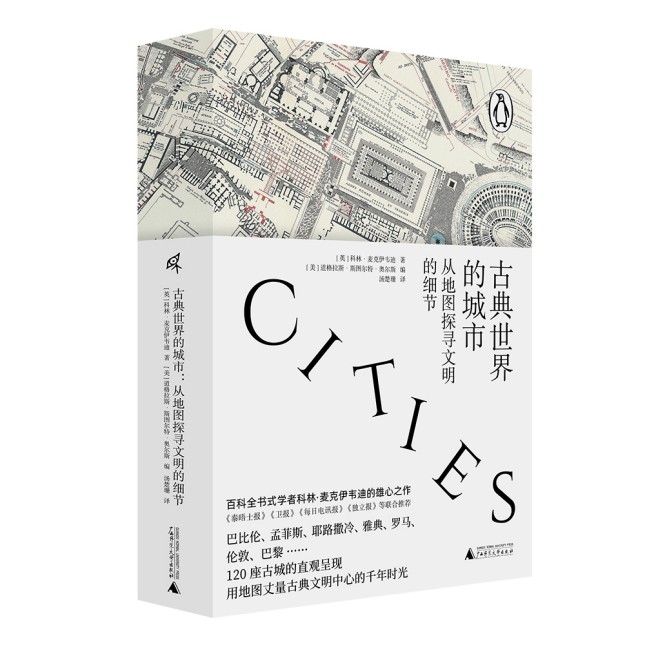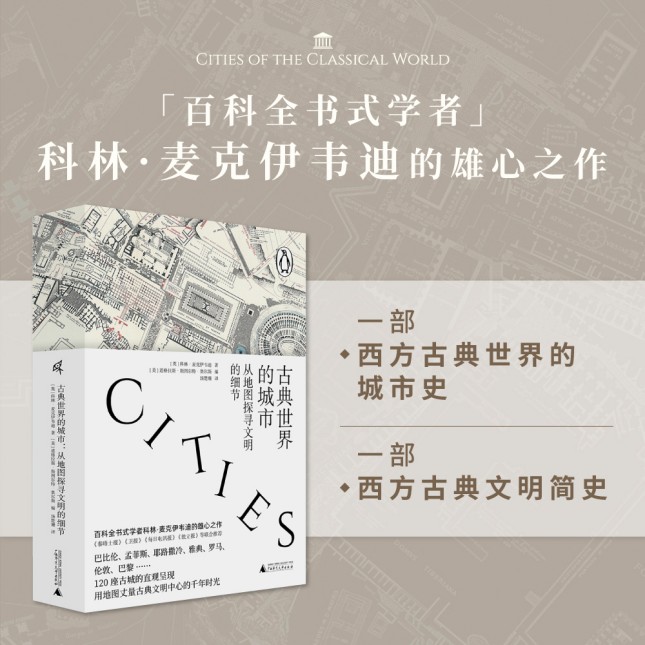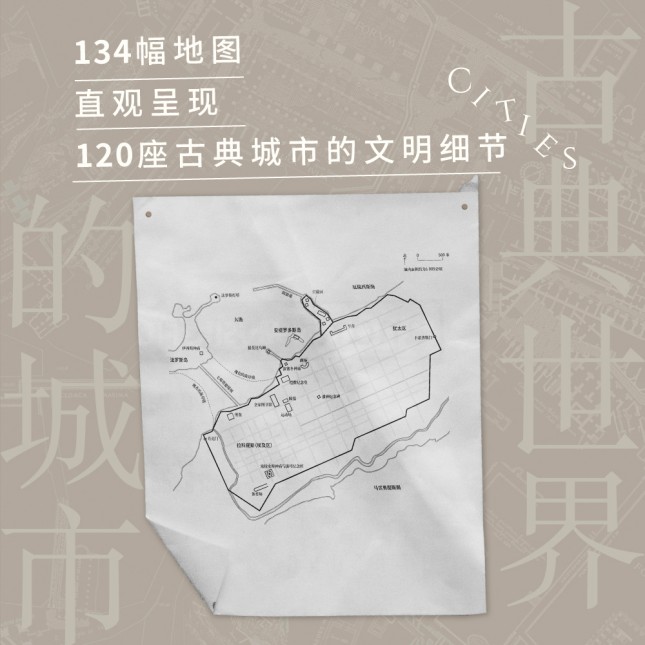Reading | Millennium of Classical Civilization Center with land maps
Author:Report Time:2022.08.22

"Classical World"
【British】 Colin McIV
[Beauty] Douglas Stewart Ols
Tang Chushan translated
Published by Guangxi Normal University Press
This book is a city history of Western classical periods and a brief history of classical civilization. The author traced back to the history of the 120 ancient cities, focused on clarifying their development in the classical period, and also explained that they were abandoned or survived to this day. When analyzing the location and terrain of the city, the author uses a unified proportion to draw a flat map of the city, which intuitively presents the layout and scale difference between different cities.
>> Selected reading in the text:
Introduction (excerpts)
Douglas Stewart Ols
Colin Peter McIVi, who was called "psychiatrist, historians, population statisticsers and scholars" by the British "Independence", was born on June 6, 1930 in Suo Kaixia County Suo Erford is the third son of a surgeon. His father sent him to Haro Gong. There, he fell in love with jazz and ancient history, and received a scholarship from Modarin College, Oxford University. During this college, McGidi raised a python as a pet.
Despite his high enthusiasm for history, McIVDIDII catered to the expectations of his family and followed the medical care of the two brothers. In fact, he is widely known as a psychiatrist. In 1970, he published two controversial papers during his work at Midelsex Hospital, which was about a mysterious epidemic. Fifteen years ago, the epidemic attacking the 300 resident nursing staff at the Royal Liberty Hospital. However, no patient was infected and the pathogen was not found. McGidi said that this epidemic is a transliteration of rigidity caused by fear of infection of pediatric paralysis. The medical community did not readily accept this view, and then argued a debate. In 1972, he was appointed as a psychiatric consultant doctor at Yiling Hospital to help the hospital design a new type of first -aid ward so that each patient can have a separate room.
As a result, Colin McIwydi's more well -known identity is an author who published more than 6 historical contests. Most of these icons are still selling, and they are attached to the map of self -made (originally hand -painted). They are translated into a variety of languages and are loved by historians, teachers and ordinary readers.
In 1978, McGidi and Richard Jones published the "Atlas of World Popuration History", which reflected his long -term interest in population growth and transfer. Subsequently, he conceived a cities in the area of the Roman Empire that reached 10,000 people into a separate entry. His idea is to draw a map for each city, and each map adopts a pass ratio. This unprecedented method will easily understand the differences in the scale of different cities. By the time McIwadi died, he was about to complete the most ambitious job from many aspects. This work that made him often feel difficult to complete and shelved many times but repeatedly regained it.
After many years of compilation of this atlas, a large number of reference materials have been used. Some literatures are rare, and some have never been translated into English. In the process of research, McIVDIDI not only used his rich collection of books, but also spent a lot of time studying in the unmanned racks in London Library. In his later years, he focused on the more professional hidden in the classic library of the House of House.

Over time, McIVDIDIDE's ambitions for this atlas have continued to expand. He has added small towns that he thinks that ordinary readers will be interested in, although these towns do not reach the initial standards of 10,000 people. He also tried to estimate the population of the city in combination with the historical materials of text and the area surrounded by the area surrounded by the city walls of each city. McIVDIDIDIDIDE has a conservative attitude towards population estimation and believes that many modern historians have a high infer of the population density of ancient cities. Because of the integration of complex information, he explained that his reasoning was clear and convincing.
Although McIwadi's research and the maps drawn reflect the work results of many other historians and archaeologists, it should not be regarded as indirect research. He personally visited most cities he listed and liked to investigate the terrain and disabled of each place. In 1996, I was fortunate to accompany McGididi to travel, including visiting the town of Telinus. On that day, more than one residents living beside the old city wall were surprised to see that a British wearing dark gray fine stripes walked along the top of the city wall and tried to measure the correct size.
When McGidi died on August 1, 2005, most of its urban historical data was stored in the early Macinta Tower computers, which was difficult to recover. His hand -painted maps are classified and sorted by neatly stacked folders, and a large number of notes in it prove the hard work of his research. For some time, the fate of this local atlas is uncertain, mainly because the author failed to integrate the final sporadic issue. But when Penguin proposed to publish a book, I have the motivation to solve these problems again. Some cities in the McIwadi folder are roughly sketching to be edited. At the same time, readers will also find that some information in the text is free (some cities lack an ancient population estimate). In addition, the author seems to want to summarize the population of all cities through a historical chart of a combination, and this work has never been completed. However, this book has been concluded in other aspects. Familiar readers who are familiar with McIwedi have always been lively and timely, and they will find that this book has the same high level as its previous historical atlas. Although many people must only pick up a few cities related to their own interests, for those readers who spend time reading this atlas, this book is valuable. These entries vividly and comprehensively described the typical period of some ancient urban development (in many cases) within the vast Roman Empire, and also explained the sources of many famous place names. The rise and fall of various society has some common reasons and affected by many unique factors, and these factors will help explain their subsequent reconstruction or abandonment in modernity.
Briefly introduced outside 120 ancient cities, this internal atlas also provided a useful expansion reading book for readers interested in specific cities -on the basis of the author's reference book, it slightly supplemented the important publishing since its death. literature. Historians to draw themselves, combining maps with the views emphasized in the text may be rare; and historians have the rich professional knowledge of population statistics, it is even more unusual. Require. In addition, in the era of academic professionalism with a small historical monograph on the publication of publication, McIVedi condensed politics, military, economy, architecture, and culture. Rare. At the same time, his article also has a calm judgment and a subtle sense of humor. This allows McIVdi's historical atlas to have a large number of readers, and it is still a popular historical entry reading.
When appreciating McGidi's academic research and its beautiful writing, it is a pity that it will not detect its personality charm. McIVDIDIdi draws a map in the underground workshop in the Hammez area of Western London. There, various sketches and reference materials were often scattered on his working table to draw the outline of the specific city where his interest was. His complicated collection also includes a bunch of obscure plane maps and booklets he obtained when he studied the cities he studied.

Although McIwadi will specialize in some materials about specific locations due to the need for research, he is actually interested in all kinds of books. Scholars allow him to find a common interest topic with anyone who is active in thinking, which also explains why a variety of people have gathered at his memorial service. They shared the memories of McIwydi, the topic from history to art, language, science, and even the first -level Formula results or movies that recently attracted him.
McIwardi can talk about the authoritative topics of almost all historical related topics, but he is also a good listener. He is willing to question the existing views, and it seems that he also likes to test new theories through sharing with interested people. He is very knowledgeable, but he is friendly and has no arrogant attitude. When leaving the book, he would have a bizarre sense of time, which made him difficult to get along with the stupid people. If you find that there is no wise conversation or no one shared his cynical humor, sometimes he will quietly slip away and return to his research.
The three daughters of Colin McIVdi inherited his amazing collection of books. From their bodies, it can be seen that Father's love for art and history, and the tolerance of the world's diversification. Without their support, this final atlas will never be completed. McIwadi clarified the complex clues that weaved our modern cities in the past. For readers who know how to cherish this, this book is also the last gift.
Author: Douglas Stewart Ols
Edit: Zhou Yiqian
Editor in charge: Zhu Zilong
- END -
Lile and Music Shandong | Yantai: The Fourth Yantai Citizen Cultural Festival Citizen Plaza Dance Contest Final will be staged in Binhai Plaza!

Tonight, a new chapter will be opened in the Yantai Coast Music Season to enter th...
Let red genes pass on from generation to generation -actively carried out red interpreters throughout the country to enter the campus activities

In May of this year, the General Office of the Ministry of Culture and Tourism joi...